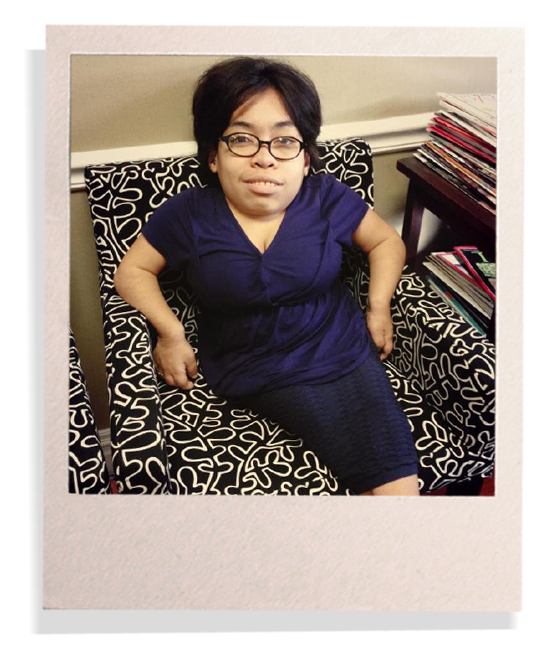TYPES OF DWARFISM
MARIA - Morquio Syndrome
I was a long and slender baby. The pediatrician predicted that I would be a tall model. My parents were in for a surprise, though I showed no symptoms yet, I was born with Morquio syndrome type A. It wasn’t until I was almost two years old that I showed symptoms and was diagnosed. Today, as an adult, I am proud to say: I am a dwarf! I love my short height of three feet two inches, but the journey hasn’t been easy.
Let me describe a bit about Morquio syndrome (and I will go into more depth later.) I was born missing an enzyme. Not having the enzyme causes various symptoms: it caused me to be short; I have difficulties ambulating and have used an electric chair since sixth grade; and I have had many surgeries, but all of that hasn’t stop me from having fun! And, much of that fun is part and parcel of having Morquio syndrome. For example, I love to travel. I’ve visited several countries; Japan, Costa Rica, Italy, Canada, England and Switzerland, and besides I was born in New York City, moved to Vermont for high school, lived in Ohio for a year and currently I am living in Hawaii. Many of these trips were a result of becoming involved with the Morquio community. The reason I went to Italy was to attend an international meeting about Morquio syndrome and related conditions. And I went to Switzerland to tour a pharmaceutical company interested in Morquio syndrome.
Also, I am on the board of trustees of the Carol Ann Foundation and an executive director of the Morquio Conference whose original goal was to tighten the community between families, doctors, researchers and funders. It was an exciting adventure to work with a medical team and with families from across the world. Over 30 families affected by both Morquio A & B gathered together at the Nemours/duPont Hospital in Wilmington, Delaware.
I also love riding my bicycle, skiing in Vermont and swimming in the Pacific Ocean. I am an artist and a student.
I hope I have established that Morquio is a big part of me and has in great part formed who I am, and yet, at the same time it is not all of me. I think this is so for many people with Morquio syndrome. Now lets discuss what Morquio syndrome is.
Morquio syndrome is also called Mucopolysaccharidoses type IV A (MPS IV A) since Morquio is one syndrome in a family of over eight syndrome, which are all Mucopolysaccharidoses All of these syndromes, are inherited. The genetic code in your DNA dictates that specific enzymes be made whose job it is to break down the sugar, Mucopolysaccharidoses, also known as Glycosaminoglycans. Both my mom and dad carry a defective gene that does not code for a specific enzyme to beak down one of the sugar bi-product. But they don’t have Morquio syndrome because the complimentary gene does code the enzyme making enough for the job. Together my parents had a one in four chance of having a child with Morquio. My older brother is six feet tall doesn’t have Morquio, but I do. Neither of my parents knew they were carriers of this gene since they have no history of dwarfism in their families.
I inherited the defected gene from each so I have no gene that codes for one of the enzymes involved in breaking down Mucopolysacciride or Glycosaminoglycan. Just to be clear the sugar, glycosaminoglycan, is not consumed, it is not found in the foods we eat. It is manufactured in our bodies. So, Yes, that means it doesn’t matter how many sweets I eat!
The missing enzyme that all of us with Morquio don’t have --to varying extents -- is called N-acetylgalactosamine-6 sulfatase.
The product of the incomplete broken down sugar is keratan sulfate. It builds up all over my body in the vacuoles of the cells. One place keratin sulfate builds up in is the growth plates of the bones, which causes the cells to become disorganized. That is why the bones can’t grow and are misshapen. Keratan sulfate has also settled in some of the body’s tissues, organs, and as well as ligaments causing joints to be lax. If you can picture a rubber band that’s old and been stretch out and won’t tighten back up, well that is what my ligaments look like.
All together this means I’ve a very complex science body and it is very rare I am one out of every 300,000 people worldwide has this condition. If you or a friend has just been diagnosed with Morquio Syndrome I cannot stress enough how important it is to be treated by an experienced team of doctors. One of the most critical areas to watch is for neck stability. If neck fusion is called for, be sure it is performed not only with a pediatric surgeon who has done many fusions but one that does them regularly on people with Morquio. Remember, our bodies are different. Of special mention is the anesthesiologist. It is critical that she/he have a particular tool kit and practice with narrowed and crooked airways. Spinal epidurals are not recommended. (See article Anesthetic Care And Perioperative Complications Of Children With Morquio Syndrome by Mary C. Theroux, Tanvi Nerker, Colleen Ditro and William G. Mackenzie. May 29, 2012)
I am very thankful to have Morquio syndrome. It has given me the opening to meet many people with disabilities. It has provided me with a great relationship to the Little People of America community, my Morquio community. I have learned first hand about accessibility issues. I have learned quite a bit that I might have never learned if it weren’t for the fact that I am three feet two inches tall and in a wheelchair.



